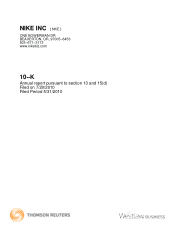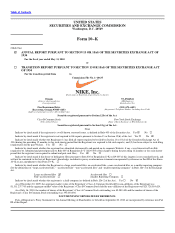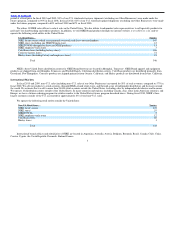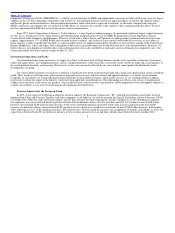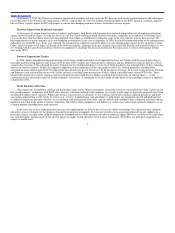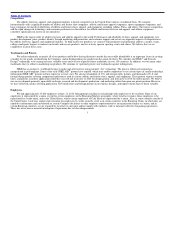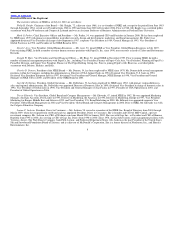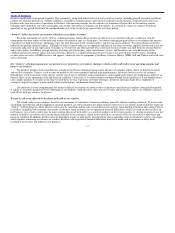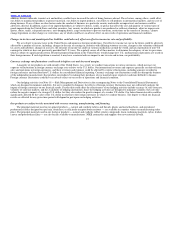Nike 2010 Annual Report Download - page 8
Download and view the complete annual report
Please find page 8 of the 2010 Nike annual report below. You can navigate through the pages in the report by either clicking on the pages listed below, or by using the keyword search tool below to find specific information within the annual report.
Table of Contents
components. During fiscal 2010, NIKE IHM, Inc., a wholly−owned subsidiary of NIKE, and independent contractors in China and Taiwan, were our largest
suppliers of the Air−Sole cushioning components used in footwear. The principal materials used in our apparel products are natural and synthetic fabrics
and threads, plastic and metal hardware, and specialized performance fabrics designed to repel rain, retain heat, or efficiently transport body moisture.
NIKE’s contractors and suppliers buy raw materials in bulk. Most raw materials are available in the countries where manufacturing takes place. We have
thus far experienced little difficulty in satisfying our raw material requirements.
Since 1972, Sojitz Corporation of America (“Sojitz America”), a large Japanese trading company, has performed significant import−export financing
services for us. During fiscal 2010, Sojitz America provided financing and purchasing services for NIKE Brand products sold in Argentina, Uruguay,
Canada, Brazil, India, Indonesia, the Philippines, Malaysia, South Africa, China, Korea, and Thailand, excluding products produced and sold in the same
country. Approximately 17% of NIKE Brand sales occurred in those countries. Any failure of Sojitz America to provide these services or any failure of
Sojitz America’s banks could disrupt our ability to acquire products from our suppliers and to deliver products to our customers outside of the United States,
Europe, Middle East, Africa and Japan. Such a disruption could result in cancelled orders that would adversely affect sales and profitability. However, we
believe that any such disruption would be short−term in duration due to the ready availability of alternative sources of financing at competitive rates. Our
current agreements with Sojitz America expire on May 31, 2011.
International Operations and Trade
Our international operations and sources of supply are subject to the usual risks of doing business abroad, such as possible revaluation of currencies,
export and import duties, anti−dumping measures, quotas, safeguard measures, trade restrictions, restrictions on the transfer of funds and, in certain parts of
the world, political instability and terrorism. We have not, to date, been materially affected by any such risk, but cannot predict the likelihood of such
developments occurring.
The current global economic recession has resulted in a significant slow down in international trade and a sharp rise in protectionist actions around the
world. These trends are affecting many global manufacturing and service sectors, and the footwear and apparel industries, as a whole, are not immune.
Companies in our industry are facing trade protectionist challenges in many different regions, and in nearly all cases we are working together to address
trade issues to reduce the impact to the industry, while observing applicable competition laws. Notwithstanding our efforts, such actions, if implemented,
could result in increases in the cost of our products, which could adversely affect our sales or profitability and the imported footwear and apparel industry as
a whole. Accordingly, we are actively monitoring the developments described below.
Footwear Imports into the European Union
In 2005, at the request of the European domestic footwear industry, the European Commission (“EC”) initiated investigations into leather footwear
imported from China and Vietnam. Together with other companies in our industry, we took the position that Special Technology Athletic Footwear (STAF)
(i) should not be within the scope of the investigation, and (ii) does not meet the legal requirements of injury and price in an anti−dumping investigation.
Our arguments were successful and the EU agreed in October 2006 on definitive duties of 16.5% for China and 10% for Vietnam for non−STAF leather
footwear, but excluded STAF from the final measures. Prior to the scheduled expiration in October 2008 of the measures imposed on the non−STAF
footwear, the domestic industry requested and the EC agreed to review a petition to extend these restrictions on non−STAF leather footwear. In December
2009, following a review of the ongoing restrictions, EU member states voted to extend the measures for an additional 15 months, until March 31, 2011. We
expect that a decision by the EC on whether to initiate a review on these measures for a second time will take place before the end of calendar 2010.
5

